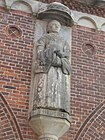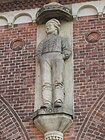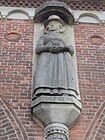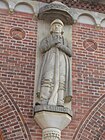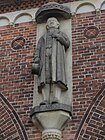|
Jens Lund (sculptor)
Jens Lund Jensen (6 February 1873 - 30 May 1946) was a Danish sculptor.[1][2] Early life and educationLund was born in 1883 in Videbæk, the son of innkeeper, merchant and farmer Jens Jensen Lund (1824-1909) and Johanne Nielsen (1831–80). He initially apprenticed both as a house painter and a diarist before training as a woodcarver under Sophus Petersen and Bertel Olsen for the age of 21 while in the same time attending Copenhagen Technical School. He studied at the Royal Danish Academy of Fine Arts from 1896 to 1901. He also worked as an assistant in Vilhelm Bissen's and Anders Bundgaard's studios. He spent three months in Italy and four months in Paris in 1906. He visited Egypt, Greece and Italy on a grant from Ankers Legat in 1914 and Germany and Austria on a grant from Zacharias Jacobsens Legat in 1922. He also made a study trip to the Netherlands and Germany in 1930.[3] CareerHe was represented at the Charlottenborg Spring Exhibition in 1900 and 1902-08 as well as the Charlottenborg Autumn Exhibition in 1904-05 and 1907. He was a member of the Den Frie Udstilling from 1911. He was also represented at exhibitions in Brighton (1912), Stockholm (Liljevalch, 1919), Gothenburg (1923 and 1939), New York City (Brooklyn Museum, 1927), Oslo (1931). He was awarded the Eckersberg Medal in 1919 for a bust in oak Kunstgips Ferdinandsen and again in 1920 for Ægyptere.[4] Lund worked with restoration of sculptures at the Danish National Gallery from 1914. He was a member of Akademirådet from March 1922, a member of the Gallery Commission in 1923-29 and was chairman of the Society for Decorative Arts (Selskabet for dekorativ kunst) and the Sculptors Association (Billedhuggerforeningen), a board member of Den Frie Udstilling and the Danish Sculptor Society (Dansk billedhuggersamfund).[5] Jens Lund was knighted in the Order of the Dannebrog in 1934. He died at Copenhagen during 1946 and was buried at Bispebjerg Cemetery. Selected works
Image gallery
References
External links |
||||||||||||||||||



